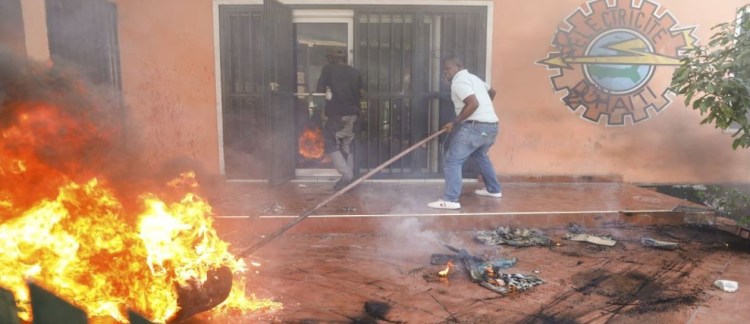Call Me Barbecue
Unless you’ve been living under a rock for the past couple of weeks, you’ve likely heard reports of widespread murder and, yes, even cannibalism in Haiti. Maybe the rumors of cannibalism got started because one of the main gang leaders in the lawless land goes by the nickname of “Barbecue.” Jimmy “Barbecue” Cherizier. He is the head of the revolutionary forces of the G9 Family and Allies. Sometimes you’ll see this abbreviated as simply “G9” or “FRG9”.
The man they call “Barbecue” is very real. He used to be a cop, then turned to the dark side to become a warlord and gang leader. Here he is in Port-au-Prince, talking with the press on March 5th.
The word on the streets is that Cherizier has been known to order his enemies set on fire, with their flesh occasionally shared as a snack among gang members. Think about it: with rumors like this circulating, how likely would you be to mess with anyone from BBQ’s gang? Not very likely, I would think. The very idea strikes fear into the hearts of their enemy.
For the record, when confronted with the allegations, “Barbecue” smiles and says the rumors exist because his parents used to own a fried chicken stand in Port-au-Prince when he was growing up. That’s a good explanation for the outside press, but I’m not sure I’m buying it.
Zombies and Cannibals
Haiti has a long tradition of deeply held cultural beliefs about the existence of flesh-eating Zombies, cannibalism, and the transformation of humans into animals. This may sound fanciful to you and me, but this is deeply embedded in their folklore and literature. People grow up believing this and, as a result, fear it.
Is the Past Repeating Itself?
Consider this fact, as referenced in the video above: More than half of the island’s residents don’t have enough to eat. Corpses are plentiful, and some have been set on fire for sanitary reasons. And it’s not like this never happened before in the island nation. On March 18th, 1864, 159 years ago to the day, eight Haitians, four women and four men, were executed by firing squad in a public square in Port-au-Prince. Their crime? All had been convicted of “stealing, killing, cooking, and eating children.”
As it turns out, this particular image was debunked as being part of a Halloween-related display in a Chinese amusement park. Who even knew the Chinese celebrated Halloween?
This event was covered by a correspondent from the New York Times who wrote:
One of the women being questioned in prison said with a leer that children ‘were good, tender, fingers best part.’ They went to the place of execution shouting, laughing and dancing, and defying the soldiers to shoot them; for they insisted that the Obeah priests would protect them against the balls. They fell, however, at the second round, and, according to the custom, the soldiers walked up to the bodies and fired a third round with the muzzles almost touching the quivering flesh.
The high-profile executions were a public event. Young and old, rich and poor, gathered in the square. Haitian President Fabre Geffard chose the day of execution personally and wanted to make an example of these four men and four women convicted of kidnapping, murdering, and cannibalizing a 12-year-old girl as part of their folk religion. Some called it voodoo, vaudaux, vandaux or vodue…it had many names.
President Geffard, trying to modernize his country, was doing all he could to stomp out the old tribal ways and turn Haiti into a modern nation. In the end, Geffard was accused of corruption and forced to flee his nation amid a bloody coup. Sound familiar?
I can’t tell you for certain whether the citizens have resorted to cannibalism or not. I’m not there to witness the goings on first hand. But I will tell you, based on their history and past practices and allegations, I’m not at all surprised that the topic is being discussed in the press today.



